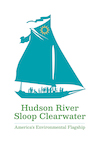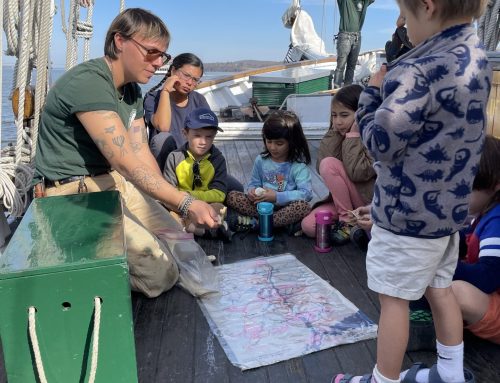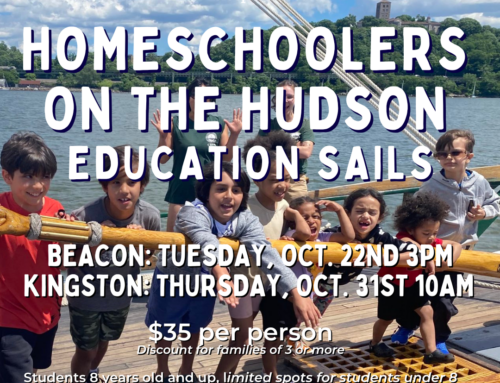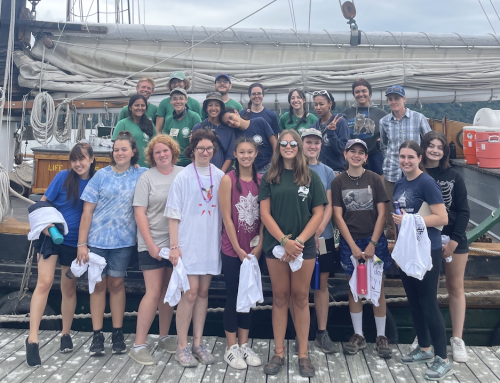By Jessica Dempsey, Mystic Whaler Education Intern
![4221941717_b0dd2b99cd[1]](https://www.clearwater.org/wp-content/uploads/2011/05/4221941717_b0dd2b99cd1-300x225.jpg) Friday May 13th has to be one of the best days aboard the Mystic Whaler yet. I’ve been here a month so far, and every group of kids still manages to surprise and delight the whole crew, so much so that we can’t stop sharing stories about our personal interactions with the students. The students from West Point Middle School were no exception. From the moment they got to the dock, it was obvious that these kids were about to give us a show. To say they were enthusiastic would almost be an understatement.
Friday May 13th has to be one of the best days aboard the Mystic Whaler yet. I’ve been here a month so far, and every group of kids still manages to surprise and delight the whole crew, so much so that we can’t stop sharing stories about our personal interactions with the students. The students from West Point Middle School were no exception. From the moment they got to the dock, it was obvious that these kids were about to give us a show. To say they were enthusiastic would almost be an understatement.
These fifth graders had studied the curriculum found on the Clearwater website, which, they informed us, was about 32 pages of information, and although they knew so much already, they took home so much more from the sloop’s hands-on learning experience. They circled up to meet their educators, loving every second. Even though the sails on Friday were earlier than usual, this 8:15am group was wide awake from the second they got off the bus to the time they left. You could see a noticeable difference in their attentiveness at the stations; they were already familiar with some of the material and so we went more in-depth and were able to test their own questions. During chemistry, I had all ears as we discussed the importance of the oxygen levels and how those levels change naturally and unnaturally. Since we were able to get through the dissolved oxygen lesson so quickly, we also did two pH tests with every student doing at least one part of the test, which seems is always the best way to do water tests.
Another amazing thing about this group of students was the fact that they could switch from being serious to being silly in seconds. When raising the sails they chose their call back to be loud and official, ‘Ready on the throat,’ instead of something silly. Then, when coming up with group names we had a lot of creativity such as the “Epic Pirate Whales” and “Toxic Muffins.” At the Navigation station, when we thought about being captains of our own vessel, we had a lot of fun coming up with dangerous situations we could avoid with the aid of the chart. In the end the whole group determined that Michael, one of the students, would be a great captain. While locating some of the chart symbols we all learned how to read buoys and found one with binoculars to locate our place on the chart.
During our moment of silence, a few minutes later, one of the students was still so excited about navigation that he was looking at other buoys to find on the chart later. Buoys and sunken ships were some of the things that the students were looking forward to see more of.
At the Life station, we had American eels. The night before we had caught three in the eel trap tied to the boat and kept two to show the students. It was exciting because not one student in the group had ever seen one of these great fish in real life. Both the boys and girls had an immediate connection to this amazing example of Hudson River life. Everyone wanted to touch the eel more than just once, even though they couldn’t really decide if the feeling was more gross than cool, or the other way around. The students had their faces practically glued to the tank to take in all the little details like the gills and nostrils.
During this sail we included the Art station to show the students some of the work of the Hudson River School Painters and to let them take some time to really focus on the river and all its detail. One of the students was really ambitious and decided to try and replicate one of the original paintings of Poughkeepsie. All of the students focused on taking in their surroundings and one said that it was all so incredible that he couldn’t even think of where to start. Even though he barely managed to draw anything at all, I could tell that he got the point of the lesson and realized how complex and beautiful the river and surrounding areas are.
The Boat Life station was another highlight for my own group. We learned about what it’s like to live aboard. How transportation had changed in the Hudson since the Dutch settled the area. We even got to visit on of the cabins aboard and made sure to pile up on the bunks. There were a few in the group who were set on staying and never returning to the dock.
The enthusiasm of the groups we had at West Point made our sails unforgettable and thankfully those will not be the last sails out of the area for this season. At the end of the second program, we were ready to let the eel go back home and decided it would be great to let the students be part of the goodbye. When the students were all shouting their “thank yous” and “goodbyes,” multiple names were called out from the various students who had named the eels. I have no doubt that in the future we might see some of these students again as volunteers or educators with the Clearwater program.

![5710178934_931021a946[1]](https://www.clearwater.org/wp-content/uploads/2011/05/5710178934_931021a9461-300x168.jpg)
![5709618449_6c79e25123[1]](https://www.clearwater.org/wp-content/uploads/2011/05/5709618449_6c79e251231-300x168.jpg)
![4700534114_7f36c7e79a[1]](https://www.clearwater.org/wp-content/uploads/2011/05/4700534114_7f36c7e79a1-300x168.jpg)



